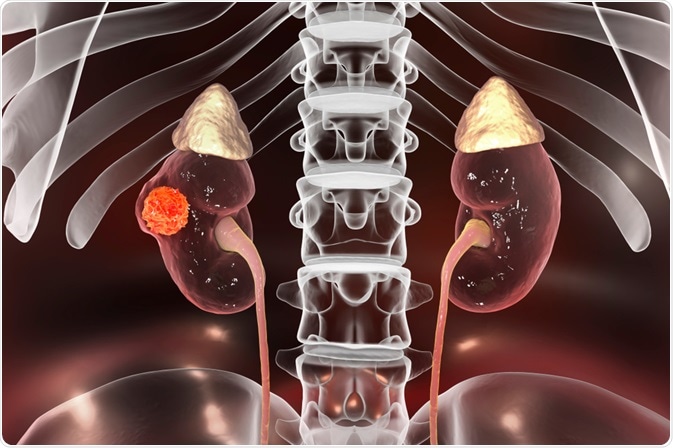Kidney cancer is cancer that grows in the kidneys, structures that lie behind the abdominal organs on either side of the spine.

Kidney Cancer. Image Credit: Kateryna Kon/Shutterstock.com
Among adults, the most common form of kidney cancer is renal cell carcinoma, which accounts for around 90 to 95% of primary malignant kidney tumors. About 65,000 cases of renal cell carcinoma are diagnosed each year in the U.S, with cancer affecting slightly more men than women. Individuals affected by the condition are usually aged between 50 and 70 years.
In the majority of cases, symptoms do not present until later on in the course of the disease, when a tumor is already large and may have spread (metastasized). The most common symptom to manifest is hematuria (blood in the urine), followed by flank pain, a palpable mass, and unexplained fever. Hypercalcemia (high blood calcium) is also common and may require treatment.
Renal cell carcinoma is diagnosed based on blood and urine tests, computed tomography (CT) and magnetic resonance imaging (MRI) scans, and sometimes biopsy. The condition is treated with surgery or targeted therapy in cases of early disease, and palliative therapy is the treatment approach in cases of advanced disease.
Kidney cancer staging
Once a physician has diagnosed kidney cancer, they will determine the stage of cancer, which may include further CT scans or other imaging tests.
Kidney cancer is staged as follows:
Stage 1: The tumor is up to 7 cm in diameter and confined to the kidney.
Stage 2: The tumor is larger than 7 cm in diameter but still confined to the kidney.
Stage 3: The tumor has grown beyond the kidney into surrounding tissue and possibly a nearby lymph node.
Stage 4: The tumor has spread beyond the kidney, to more than one lymph node or other parts of the body such as the liver, lungs, or bones.
At the stage of diagnosis, renal cell carcinoma is confined to the kidney in 45% of cases, it is locally invasive in around 33% of cases and it has spread beyond the kidney to other organs in around 25% of cases.
Survival rates
As with many other forms of cancer, the patient outcome depends on the cancer stage at diagnosis, the cancer grade at diagnosis, the patient’s overall health, and age.
The grade of a cancer is decided based on how it appears under microscopic examination. Grading is divided into four stages depending on the size and appearance of the nuclei in the cancer cells. Grade 1 is the lowest grade and grade 4 is the highest grade, with grade 4 tumors more likely to grow rapidly and spread than grade 1 tumors.
Survival is also affected to an extent by age. Younger individuals tend to survive for slightly longer than older individuals, which may be partly due to better overall health, treatments generally being more effective among younger people, and the likelihood of the illness being diagnosed during the earlier stages.
Cancer survival rates are described in terms of the proportion of patients who survive for a given time period after they have been diagnosed with cancer. Generally, survival is talked about in terms of 1-year, 5-year, and 10-year survival rates. However, these are only terms that doctors use and a 5-year survival rate, for example, does not mean a patient will only live for five years.
The number is derived from follow-up research to evaluate the number of people still alive five years after their diagnosis. The risk of cancer returning after five years is minimal, but physicians are reluctant to use the term “cure” due to this small risk of recurrence, and instead, the term 5-year survival is used.
Survival statistics are therefore designed to give an estimate of a patient’s likelihood of survival but do not provide a definitive predictor of how long a patient will live. In the case of kidney cancer, around 72% of those diagnosed live for at least one year after diagnosis, about 56% live for at least 5 years and about 50% live for 10 years or more.
According to the American Cancer Society, the 5-year survival rates after a diagnosis of renal cell carcinoma are as follows:
- For stage 1 tumors, the patient outlook is generally good if patients are well enough to undergo treatment and the 5-year survival rate is around 90%.
- For stage 2 tumors, the 5-year survival rate is between 65% and 75%. Those with a low-grade (slow-growing) cancer are more likely to survive and be fit and well.
- For stage 3 tumors, the 5-year survival rate is between 40% and 70%, with patients more likely to survive if they are fit and well and the cancer is lower grade.
- For stage 4 tumors, the overall 5-year survival rate is reduced to around 10%, but this depends very much on cancer grade. In cases of low-grade cancer and only local spread, the 5-year survival rate can be as high as 40%.
As symptoms are often absent in the early stages of the disease, renal cell carcinoma is often only detected once it has already reached an advanced stage. If cancer has already spread (or metastasized) to other parts of the body, it cannot be cured and treatment is instead focused on slowing disease progression and alleviating symptoms.
References